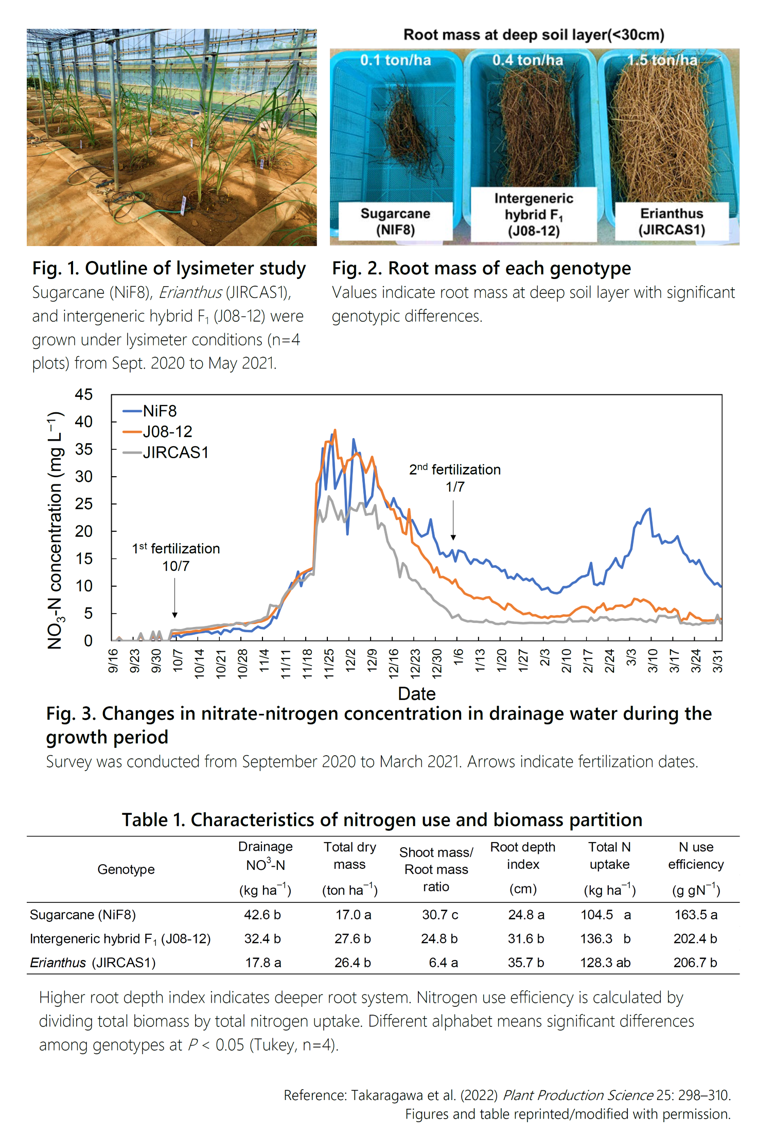Intergeneric hybrid between sugarcane and Erianthus exhibits superior nitrogen use efficiency than sugarcane
Description
Nitrate-nitrogen leaching from farmland has adverse effects on drinking water and environmental conservation in tropical and subtropical island regions such as the Southwest Islands of Japan. Sugarcane is widely grown in these areas, and it is necessary to increase the nitrogen use efficiency of this crop to reduce nitrogen leaching. Studies on nitrogen utilization in this species have focused on yield potential and fertilizer management; however, there have been only a few breeding attempts. The relationship between root system characteristics and nitrogen utilization is also unclear, while improvement of nitrogen utilization using Erianthus arundinaceus can be expected because of its unique root system characteristics. In the present study, nitrogen leaching and root system characteristics of sugarcane × Erianthus intergeneric hybrid and parental genotypes were investigated using a lysimeter to verify the possibility of improving nitrogen utilization characteristics.
Nitrogen leaching was significantly lower under the parental Erianthus from the early growth stage, while it was significantly lower in the intergeneric hybrid in the mid-growth stage than that in the parental sugarcane. The nitrogen use efficiencies of Erianthus and the intergeneric hybrid were significantly greater than that of sugarcane. Erianthus and the intergeneric hybrid exhibited lower shoot/root ratio and deeper rooting than sugarcane and consumed significant amounts of soil moisture in the deeper layers, suggesting that root mass and deeper rooting may be factors in reducing nitrogen leaching. These results indicate the possibility of improving the nitrogen utilization characteristics of sugarcane by improving its root system characteristics using Erianthus.
The intergeneric hybrid F1 can be used to breed sugarcane varieties that contribute to reductions of nitrogen leaching and fertilization. However, it is necessary to improve the sugar content of the F1 line through backcrossing with sugarcane varieties in order to utilize it as a variety for sugar production because the F1 line has low sugar content at harvest season. In addition to root elongation characteristics, nitrate preference may also be related to greater nitrogen use efficiency, which should be investigated in future studies using the N15 tracer method.
Figure, table
- Research project
- Program name
- Term of research
-
FY2020–2021
- Responsible researcher
-
Takaragawa Hiroo ( Tropical Agriculture Research Front )
ORCID ID0000-0002-6238-1078KAKEN Researcher No.: 70851260Okamoto Ken ( Tropical Agriculture Research Front )
Teraiima Yoshifumi ( Tropical Agriculture Research Front )
Anzai Toshihiko ( Tropical Agriculture Research Front )
- ほか
- Publication, etc.
-
Takaragawa et al. (2022) Plant Production Science, 25, 298–310.https://doi.org/10.1080/1343943X.2022.2097098
- Japanese PDF
-
2022_A09_ja.pdf1.01 MB
- English PDF
-
2022_A09_en.pdf791.64 KB
* Affiliation at the time of implementation of the study.

